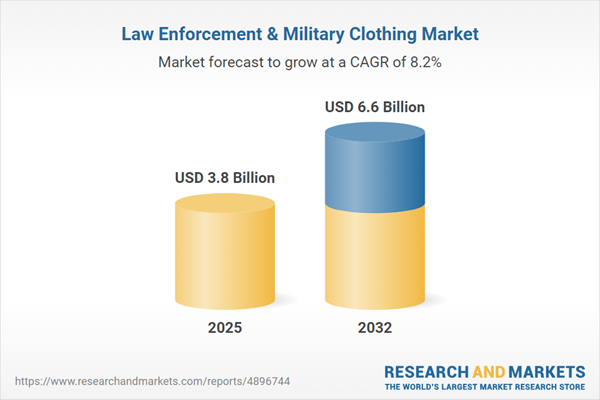Speak directly to the analyst to clarify any post sales queries you may have.
The law enforcement and military clothing market is rapidly transforming as organizations shift procurement strategies to prioritize high-performance apparel and adaptive solutions. As operational requirements grow more complex, senior decision-makers must balance regulatory compliance, safety, and the need for mission-ready gear, all within dynamic global conditions.
Market Snapshot: Law Enforcement and Military Clothing Market
The global law enforcement and military clothing market is projected to reach USD 6.60 billion by 2032, driven by a compound annual growth rate (CAGR) of 8.23% between 2024 and 2032. Growth in this sector reflects sustained demand for next-generation uniforms and advanced protective equipment, increasingly influencing procurement trends worldwide. Organizations are integrating apparel solutions that enhance both operational effectiveness and individual safety. Adapting supply chain models to address rapidly changing regulations and emerging security threats has become a strategic imperative. Innovation around smart textiles and advanced material technologies is equipping procurement and operations leaders with tools to meet shifting mission requirements across varied regions and operational landscapes.
Scope & Segmentation: Law Enforcement and Military Clothing Market
- Product Categories: Includes tactical vests, field jackets, ceremonial uniforms, deployment-focused clothing, and body armor, ensuring broad applicability across multiple functions and duty environments.
- Body Armor Types: Covers hard armor materials such as ceramic, steel, and composites alongside modular carriers and soft armor constructed from UHMWPE and aramid fibers for adaptable threat protection.
- Outerwear and Jackets: Features parkas and softshell jackets designed to deliver resilience and comfort, supporting personnel in diverse climates and rigorous field settings.
- Pants: Highlights garments with reinforced engineering to improve flexibility, durability, and unrestricted movement in prolonged or high-intensity deployments.
- Tactical Vests: Comprises modular platforms compatible with MOLLE systems, enabling streamlined access and fast reconfiguration to suit evolving tactical requirements.
- Uniforms: Incorporates solutions with adaptive camouflage and options for high visibility, supporting the needs of varying operational theaters and compliance mandates.
- End Users: Addresses the requirements of law enforcement agencies, border security, tactical response units, and military forces, each with specific operational and regulatory considerations.
- Key Regions: Focuses on regions such as the United States, United Kingdom, China, and India, where procurement decisions and regulatory frameworks heavily guide demand and supplier engagement.
- Technologies: Spotlights technical fibers, smart apparel capabilities, modular construction, additive manufacturing, and digital integration solutions aimed at enhancing protection and enabling real-time data transmission.
- Major Companies: References key suppliers including Propper International, 5.11, Crye Precision, FirstSpear, 3M, Honeywell International, and DuPont de Nemours, each offering extensive product portfolios and international support networks.
Key Takeaways for Senior Decision-Makers
- Adaptive uniform systems help streamline readiness measures and simplify logistics across organizational units, fostering agile responses to operational shifts.
- Comfort-focused garment engineering strengthens endurance and allows greater freedom of movement, supporting workforce performance during intensive or extended field assignments.
- Modular equipment designs provide flexibility for rapid adjustments, ensuring teams can realign resources efficiently as priorities and conditions change.
- Ethical sourcing and responsible supply chain practices reinforce compliance initiatives and mitigate risks linked to regulatory and reputational exposure.
- The integration of digital communication technologies into clothing elevates situational awareness, supporting secure and immediate data exchange in complex mission environments.
- Diversified sourcing and expanded supplier networks are key to minimizing the impact of market volatility and sustaining continuous operational capacity.
Tariff Impact: U.S. Tariff Changes and Sector Response
Adjustments to U.S. tariffs on imported tactical clothing are driving sector participants to refine procurement processes, streamline logistics, and adapt compliance strategies. As organizations navigate evolving policy frameworks, proactive supply chain recalibration is critical to maintaining smooth operations and regulatory alignment within a shifting environment.
Methodology & Data Sources
This analysis employs direct interviews with procurement leaders, structured market intelligence gathering, patent landscape review, and ongoing monitoring of sector regulations. All guidance statements and recommendations have been verified by subject matter experts to ensure relevance for procurement and strategic operations professionals.
Why This Report Matters
- Supports effective supplier benchmarking and sourcing optimization for sustained growth in the law enforcement and military clothing sector.
- Delivers insights to bolster supply chain resilience, facilitate regulatory compliance, and manage transformation as operational dynamics progress.
- Clarifies how technology advancements and sustainability objectives are enabling improved vendor strategies and long-term decision planning.
Conclusion
By strategically coordinating apparel procurement, organizations can stay agile, mitigate compliance risks, and meet evolving mission demands as conditions change globally.
Additional Product Information:
- Purchase of this report includes 1 year online access with quarterly updates.
- This report can be updated on request. Please contact our Customer Experience team using the Ask a Question widget on our website.
Table of Contents
3. Executive Summary
4. Market Overview
7. Cumulative Impact of Artificial Intelligence 2025
Companies Mentioned
The companies profiled in this Law Enforcement & Military Clothing market report include:- Propper International, LLC
- 5.11, Inc.
- Under Armour, Inc.
- Crye Precision LLC
- Condor Outdoor Products, Inc.
- FirstSpear, LLC
- Blue Force Gear, LLC
- 3M Company
- Honeywell International Inc.
- DuPont de Nemours, Inc.
Table Information
| Report Attribute | Details |
|---|---|
| No. of Pages | 183 |
| Published | October 2025 |
| Forecast Period | 2025 - 2032 |
| Estimated Market Value ( USD | $ 3.8 Billion |
| Forecasted Market Value ( USD | $ 6.6 Billion |
| Compound Annual Growth Rate | 8.2% |
| Regions Covered | Global |
| No. of Companies Mentioned | 11 |








